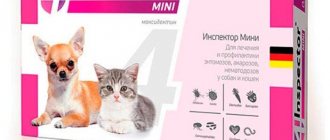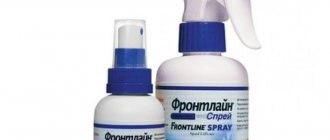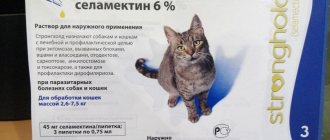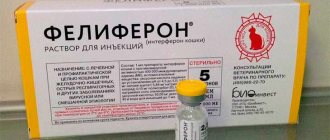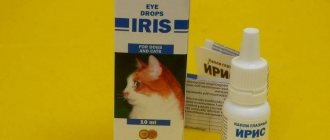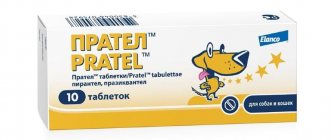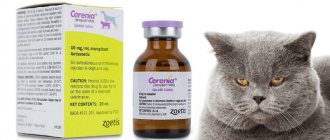Indications for use and mechanism of action of drops
Inspector Total K drops are a combined antiparasitic drug for cats and dogs. Indicated for use if your pet has fleas, ticks and helminths, as well as for the prevention of infection with ecto- and endoparasites.
The cat was tormented by fleas!
“Inspector” - drops for cats, they are prescribed for the treatment and prevention of the following diseases:
- entomosis - diseases caused by insects (fleas, ticks, mosquitoes, lice, lice);
- Otodectosis is a disease caused by ear mites;
- notoedrosis - damage to the upper layers of the skin by the parasite Notoedros Cati;
- acarosis is a skin lesion caused by microscopic itch mites;
- infection with ixodid and acariform ticks;
- toxocariasis is a helminthic infestation caused by the helminth Toxocara cati;
- toxascariasis - infestation by worms of the roundworm group;
- uncinariasis - infestation by nematode worms;
- anklystomosis - infestation by worms of the species Ancylostoma tubaeforme;
- dirofilariasis is an infestation of heartworms that infect the heart chambers of their host.
Important! Even if the cat does not go outside, it still needs to be treated! People bring helminth and flea eggs on outdoor shoes.
The active ingredients of the drops - fipronil and moxidectin - paralyze the nerve receptors of parasites, which leads to their paralysis and death.
After applying the drug to the skin, fipronil is distributed over the surface of the cat's skin without being absorbed into the bloodstream. It remains on the skin and coat for a long time, providing protection against ectoparasites. Moxidectin is well absorbed into the bloodstream, kills endoparasites and provides long-term protection against them.
The drug is eliminated from the body on its own within 28-30 days.
Uninvited guests - fleas and ticks
Drops for cats 1-4 kg Inspector Quadro K from external and internal parasites
Inspector Quadro K is prescribed to cats for the treatment and prevention of entomosis, otodectosis, notoedrosis, acarosis caused by ixodid ticks, nematodes of the gastrointestinal tract (toxocariasis, toxascariasis, uncinariasis, hookworm disease), cestodiasis (tenidosis, dipylidiasis, mesocestoidosis, diphyllobothriasis ), as well as in for the prevention of dirofilariasis. It is known that pets are at risk of infection with countless parasites all year round: ticks, fleas, and all kinds of helminths. Usually, to protect and prevent a pet, it was necessary to use 2 types of drugs: insectoacaricidal (against external parasites) and anthelmintic (against internal parasites). Now there is a simple solution - Inspector QUADRO, a complex drug against 20 external and internal parasites.
Quad protection:
- from ticks;
- insects and their larvae;
- round helminths, including heartworms;
- tapeworms.
Safely:
- It is possible to treat cats and dogs of all breeds without restrictions.
- Treatment of pregnant and lactating females is allowed.
- Allowed for use by puppies and kittens from 3 weeks of age.
- For preventive purposes, the drug can be used throughout the year.
Comfortable:
- A wide range of application forms is suitable for any animal owner.
- Assortment range taking into account the type and weight of the animal.
- The drug is used by animals by applying it to dry, intact skin, breaking off the upper part of the pipette.
General information:
Dosage form: solution for external use.
Inspector Quadro K in 1 ml contains as active ingredients: fipronil - 107 mg, praziquantel - 42.8 mg, pyriproxyfen - 21.4 mg and moxidectin - 10.7 mg, as well as excipients: diethylene glycol monoethyl ether (DEME), N – methylpyrrolidone, butylated hydroxyanisole, butylated hydroxytoluene.
In appearance it is a transparent oily liquid from colorless to yellow.
Inspector Quadro K should not be used after the expiration date.
Store the drug in the manufacturer's sealed packaging, in a place protected from direct sunlight, separately from food and feed, at a temperature from 00C to 300C and a relative humidity of no more than 60%.
Inspector Quadro K should be kept out of the reach of children.
Unused medicinal product is disposed of in accordance with legal requirements.
Pharmacological properties:
Inspector Quadro K belongs to the pharmacotherapeutic group of antiparasitic drugs in combinations.
The active components included in the drug provide its wide spectrum of antiparasitic action against sarcoptoid ticks (Notoedres cati, Otodectes cynotis), fleas (Ctenocephalides felis), lice beetles (Felicola subrostratus) and ixodid ticks (Dermacentor spp., Rhipicephalus spp., Ixodes spp.) , as well as larval and mature phases of development of nematodes (Toxocara mistax, Taxascaris leonina, Uncinaria stenocephala, Ancylostoma caninum), cestodes (Dipylidium caninum, Alveococus multilocularis, Taenia spp., Mesocestoides lineatus, Diphyllobothrium latum), larval phases of development (microfilaria) Dirofilaria immitis and Dirofilaria repens, parasitic in cats.
Fipronil is an insectoacaricide of the phenylpyrazoles group; its mechanism of action is to block GABA-dependent arthropod receptors, disrupt the transmission of nerve impulses and the activity of the nervous system, which leads to paralysis and death of ectoparasites.
Praziquantel is a compound of the pyrazinisoquinoline group that has a pronounced effect against mature and immature cestodes; its mechanism of action is based on inducing the disintegration of the tegument and inhibition of fumarate reductase, persistent depolarization of helminth muscle cells, disruption of energy metabolism, which causes paralysis and death of cestodes and promotes their removal from the gastrointestinal tract.
Moxidectin is a semi-synthetic compound of the milbemycin group (macrocyclic lactones), having a stimulating effect on the release of gamma-aminobutyric acid and binding to postsynaptic receptors, causing disruption of muscle innervation, paralysis and death of ectoparasites and nematodes.
Pyriproxyfen, disrupting the hormonal balance of arthropods, causes developmental anomalies and sterilization of adults. The mechanism of action of pyriproxyfen is to disrupt the processes of chitin synthesis and molting of larvae, prevents the development of full-fledged pupae and causes the death of insects in the preimaginal phases of development, which leads to the cessation of replenishment of the ectoparasite population.
After skin application, fipronil and pyriproxyfen, which are part of the drug Inspector Quadro K, are quickly distributed over the surface of the epidermis and have a contact insectoacaricidal effect, preventing infestation by insects and ticks. Moxidectin and praziquantel penetrate the systemic bloodstream, are distributed in organs and tissues and have a systemic antiparasitic effect on intestinal nematodes, cestodes, heartworm larvae migrating in the bloodstream, as well as sarcoptic, demodectic and ixodid ticks. The insectoacaricidal and anthelmintic effect of the drug after a single treatment lasts 4-6 weeks.
In terms of the degree of impact on the body, Inspector Quadro K is classified as a moderately hazardous substance (hazard class 3 according to GOST 12.1.007-76); in recommended doses it does not have a locally irritating, resorptive-toxic or sensitizing effect. The drug is toxic to rabbits, bees, fish and other aquatic organisms.
Application procedure:
Inspector Quadro K is prescribed to cats for the treatment and prevention of entomosis, otodectosis, notoedrosis, acarosis caused by ixodid ticks, nematodes of the gastrointestinal tract (toxocariasis, toxascariasis, uncinariasis, hookworm infection), cestodiasis (taenidosis, dipylidiasis, alveococcosis, mesocestoidosis, dipylidiasis). phyllobothriasis), as well as for the prevention of dirofilariasis.
A contraindication to the use of Inspector Quadro K is the individual hypersensitivity of the animal to the components of the drug. It is not allowed to use the drug aurically (for ear scabies) if the eardrum is perforated. Patients with infectious diseases and weakened cats and animals of other species cannot be treated.
Cats weighing less than 1 kg should be treated with caution under the supervision of a veterinarian.
When working with Inspector Quadro K, you should follow the general rules of personal hygiene and safety precautions provided for when working with medicines. While working with the drug, smoking, drinking and eating are prohibited. When finished, wash your hands thoroughly with warm water and soap. The animal should not be petted or allowed near small children for 2 days after treatment. People with hypersensitivity to the components of the drug should avoid direct contact with Inspector Quadro K.
In case of accidental contact of the drug with the skin or mucous membranes of the eyes, they must be rinsed with plenty of water. If allergic reactions occur or if the drug accidentally enters the human body, you should immediately contact a medical facility (bring the instructions for use or label with you).
Kittens under 7 weeks of age cannot be treated. Treatment of cats during pregnancy and feeding of offspring, if necessary, is carried out with caution under the supervision of a veterinarian.
When treating cats weighing more than 15 kg, the drug is used at the rate of 0.1 ml per kilogram of animal weight, using a combination of pipettes or tubes of various packaging; when treating cats weighing less than 1 kg - at the rate of one drop of solution (0.05 ml) per 0. .5 kg of animal weight.
To kill fleas, lice and ixodid ticks, the drug is applied dropwise (“spot-on”) to the skin in places inaccessible for licking - between the shoulder blades at the base of the neck. Treatment of animals for therapeutic purposes is carried out once, to prevent re-infestation - once every 4-6 weeks throughout the entire season of ectoparasite activity.
In order to prevent re-infestation by fleas, the animals' bedding is replaced or treated with an approved insecticide in accordance with the instructions for use.
The acaricidal effect of the drug manifests itself after 12-24 hours; taking this into account, treatments should be carried out no later than 24 hours before the intended walking of animals in places where ixodid ticks may live (parks, squares, forests).
To destroy attached ixodid ticks on the body of an animal, Inspector Quadro K in the amount of 1 drop is applied to the tick and the place of its attachment to the skin. If the tick does not fall off spontaneously within 20 minutes, it is carefully pulled out of the skin with tweezers and destroyed.
To treat otodectosis, the external auditory canal is cleaned of scabs and crusts, then 3 drops of the drug are instilled into each ear (the drops must be injected into both ears), the auricle is folded in half and its base is massaged. The remainder of the drug in the pipette or tube used (based on the weight of the animal) is applied to the skin between the shoulder blades. Treatment is carried out 2-3 times with an interval of 7-10 days. When complicated by otitis media, antimicrobial and anti-inflammatory drugs are prescribed.
If necessary, the course of treatment is repeated after 1 month under microscopy control of scrapings.
In case of perforation of the eardrum, the drug is used by drip application to the skin between the shoulder blades at the base of the neck in the dose indicated in the table.
With notoedrosis. Inspector Quadro K is applied in a thin layer to the affected areas of the body, previously cleared of scabs, covering up to 1 cm2 of borderline healthy skin at the rate of 0.1 ml per kg of body weight. Treatment is carried out 2-4 times with an interval of 7-10 days. Animals with large affected areas are treated in two doses with an interval of 1 day, applying the drug to the affected areas of first one and then the other half of the body. Treatment is recommended to be carried out comprehensively with the use of pathogenetic and symptomatic drugs until the animal’s clinical recovery, which is confirmed by two negative results of microscopic examinations of scrapings.
To prevent licking of the drug, the animal is put on a muzzle, a cervical collar, or the jaws are closed with a loop of braid, which are removed 20 minutes after applying the drug.
For deworming, Inspector Quadro K is used by applying to the skin in the doses indicated in the table, for therapeutic purposes once, for prophylactic purposes - once a month.
In order to prevent dirofilariasis in regions unfavorable for the disease, the drug is used in the spring-summer-autumn period: before the start of summer against mosquitoes and mosquitoes (carriers of the pathogen D. Immitis) once, then once a month and the last time in the season 1 month after the end of flight insects
Inspector Quadro K does not destroy sexually mature dirofilariae, but reduces the number of microfilariae circulating in the blood and can also be safely used by infested animals.
The drug should not be applied to wet or damaged skin; the animal should not be washed for 4 days after treatment with the drug.
As a rule, there are no side effects or complications when using the drug Inspector Quadro K in accordance with these instructions. In rare cases, individual skin reactions (redness, itching) are possible, which resolve spontaneously and do not require the use of medications. If allergic reactions occur in an animal sensitive to the components of the drug, the drug should be thoroughly washed off with soap and water and the fur should be rinsed with plenty of running water, and, if necessary, antihistamines and symptomatic agents should be prescribed.
In case of an overdose, the animal may experience depression, excessive salivation, muscle tremors, and vomiting. In this case, the drug is thoroughly washed off with water and the animal is prescribed symptomatic therapy.
Inspector Quadro K should not be used simultaneously with other antiparasitic drugs, due to possible mutual enhancement of toxicity.
No specific effects of the drug upon first use or upon its discontinuation have been identified.
Violations of the regimen for using Inspector Quadro K should be avoided, as this may lead to a decrease in its effectiveness. If the next treatment is missed, the use of the drug should be resumed at the same dose according to the same regimen.
Inspector Quadro K is not intended for use by productive animals.
Quantity per package: 1 pipette x 0.4 ml.
Flea drops "Inspector" - instructions for use
Advocate drops for cats: instructions for use
The drug is produced as drops on the withers for cats, in a dosage based on the weight of the animal. For 1-4 kg of weight 0.4 ml; for 4-8 kg of mass 0.8 ml. The entire pipette must be used at once.
Inspector drops for cats come with detailed instructions for use.
There is also “Inspector” for kittens in a reduced dosage. This option is called “Inspector mini” and is suitable for small breed puppies and kittens weighing from 0.5 kg. “Inspector” for kittens is used according to instructions from three weeks of age.
Drops on the withers "Inspector"
Processing technique
Inspector drops for cats are applied to the skin of the withers, closer to the neck, after spreading the fur. The withers were not chosen by chance - this is a place where the cat cannot reach with its tongue. Dosage by weight. It is not recommended to use three days before and three days after washing the animal.
Note! The drug is applied to clean, dry skin. It is important that there are no wounds, redness or alopecia (bald patches) at the site where the drops are applied.
For otodectosis (ear mites), the “Inspector” is recommended to drop a drop of the drug into each ear, after thoroughly cleaning them. The remaining drops are poured onto the withers.
Correct application of drops to the withers
How often can you use the Inspector tool?
To prevent external and internal parasites, the drug is used once every 1-2 months.
To destroy external parasites (fleas, lice, ticks, lice) - twice, with an interval of 10-14 days.
For otodectosis, drops are instilled into the ears and on the withers 2-3 times, with an interval of 14-18 days.
To prevent dirofilariasis, which is carried by mosquitoes, it should be treated every 20-22 days.
general information
The official trade name of the medicine is “Inspector Quadro K”.
Alternative names according to the international classification: praziquantel, priproxyfen, moxidectin, fipronil.
The medication Inspector Quadro K is available in the form of a liquid solution intended for external application to the pet’s skin.
Active compounds included in the drug (in terms of 0.001 l of the finished solution): 0.107 g of fipronil, 0.043 g of praziquantel, 0.021 g of pyriproxyfen and 0.011 g of moxidectin. In addition, auxiliary components are added to the solution.
The appearance of the medication is a transparent yellowish-white liquid oily substance. The composition is poured into disposable polymer pipettes with a volume of 1.5 ml, 0.8 ml and 0.4 ml. Each pipette is sealed in a separate blister, then packed in a cardboard box and supplied with instructions for use.
Where can I buy? The drug is sold in veterinary pharmacies and pet stores and does not require a doctor's prescription.
Precautionary measures
Bars drops for cats against fleas and ticks: instructions
It is best to handle drops while wearing gloves. After treatment, the cat should not be touched by the withers for 3-4 days. If contact occurs, wash hands with warm water and soap. If drops get on the nasal mucosa, in the eyes or in the mouth, immediately wash the affected areas under running water. Children should not be allowed near the cat.
If the animal nevertheless reaches out and licks drops from the withers, it is necessary to immediately see a veterinarian, without waiting for clinical signs of poisoning - vomiting, lethargy, diarrhea.
Side effects and contraindications
When used according to the instructions, Inspector Total K is as safe as possible for cats.
Blokhnet for cats: drops, instructions
Side effects include:
- lethargy and decreased appetite within 24 hours after using the drug;
- redness of the skin and itching at the site of application of the drops;
- individual intolerance - vomiting, diarrhea.
The drug is contraindicated:
- kittens less than seven weeks old;
- animals in the acute or chronic stage of an infectious disease;
- in case of individual intolerance to the drug.
Important! With severe helminthic infestation, dead helminths begin to secrete decay products directly into the cat’s intestines. If your health suddenly deteriorates, you should contact a veterinary clinic!
Visit to the veterinarian
Contraindications
Inspector Quadro K is not prescribed to cats that have been identified as having an individual intolerance to the components of the solution, as well as to kittens under 7 weeks of age. For pregnant or lactating cats, as well as young cats weighing up to 1 kg, the medication is used only under the supervision of a veterinarian. During otodectodesis, the use of the product inside the auricle is prohibited for cats in which a violation of the integrity of the eardrum has been detected.
During the period of acute infectious diseases, treatment is not prescribed, since during this period the cat’s body is weakened by the fight against infection. The product is contraindicated for exhausted and weak animals.
Inspector Quadro K is prohibited for use on farm animals producing food.
Efficiency
When used in accordance with the instructions, “Inspector” does its job really well - fleas and ticks die within 3-4 hours after treatment, worms within 5-6 hours. Sometimes repeated treatment is required in order to “finish off” new individuals hatched from eggs.
Delcid
“Inspector” is an effective flea and tick drug for cats and does not pose a serious danger to the health of people and animals.
For more effective treatment against worms, veterinarians advise giving the cat a tablet 10-14 days after treatment with drops. Since “Inspector” drops for cats do not always work against worms.
Note! Since parasites do not live on cats, but only feed, if a flea or helminthic infestation is detected, the apartment must also be treated. It is better to throw away the pet's beds and pillows or wash them in a Delcid solution with bleach.
Advantages and disadvantages
Among the advantages of the drug "Inspector Total K" are the following:
- high efficiency against external parasites;
- ease of use;
- no strong odor from the drops;
- wide spectrum of action;
- the company has drops for both cats and kittens, and for dogs and puppies;
- adequate price tag.
The disadvantages of the drug "Inspector" are as follows:
- poor effectiveness against internal parasites, sometimes additional treatment for worms in the form of a tablet is necessary;
- individual allergic reactions;
- the drug does not kill flea and helminth eggs;
- From the drops, the pet's fur becomes oily 3-5 days after treatment.
Effective analogues
If you have an individual intolerance to the drug “Inspector”, the following analogues are suitable:
Effective analogues
- "Stronghold" for cats, the active ingredient is selamectin. Does not help against ixodid ticks.
- “Prazicide”, the active ingredients are praziquantel, levamisole and ivermectin.
- "Advantage", active ingredients - permethrin and imidacloprid.
- "Advocate", the active ingredients are imidacloprid and moxidectin.
Important! You cannot use several antiparasitic drugs at once. This can cause severe intoxication of the body.
Don't forget how important protection against parasites is for animals. Parasitic diseases are a serious problem, and only the owner can protect their animal.
Compound
Inspector contains fipronil and moxidectin as the main active ingredients. The medicine is low-hazard and non-toxic. Excipients (dimethyl sulfoxide, isopropanol, polyethylene glycol (PEG400), butylated hydroxyanisole) enhance the effect of the main ones.
To avoid side effects, drops should be used with the permission of a veterinarian. It is important to follow the instructions to avoid overdose.
Instructions for use
Instructions for using drops Inspector for cats from the official website of the manufacturer
Detailed instructions are downloaded in PDF file format, click here to view.
